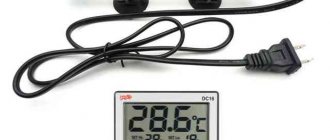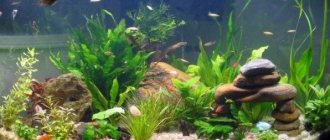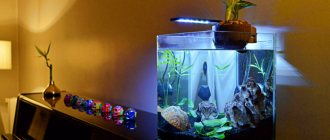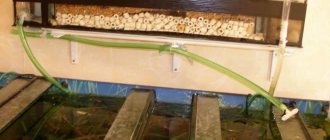An aquarium is not just a decorative element, it is an ecosystem. In order to admire swimming fish in clear water, they need to be provided with optimal conditions: lighting, heating, oxygen access. An aquarium filter is one of the main elements in the functioning of an artificial indoor pond. It purifies water from mechanical debris and fish waste products, regulates biological balance, and saturates the water with oxygen. Instructions on how to install a filter in an aquarium so that it functions correctly will be presented below.
What is an aquarium filter?
This is a structure that is installed either inside the aquarium or next to it. It consists of a compartment for filter materials and an electric pump, which promotes the movement of water and various fillers. They are based on materials that trap debris, chemicals or special bacteria. Each filtering method has its own strengths and weaknesses. In addition, the choice also takes into account the volume of water that the aquarium filter is capable of processing without replacing elements in accordance with the dimensions of the tank.
How to properly install an internal filter in an aquarium
An aquarium filter is one of the most important parts in a home pond, prolonging the life of waterfowl. Cleanliness depends on it, because the device provides mechanical and biological cleaning, and also saturates the water with oxygen. The installation of this device may be different, depending on its type and purpose. It is sometimes difficult for a novice aquarist to understand the instructions that come with the filter, so it is worth considering in detail the types of aquarium filters and the rules for installing them.
External filters
Suitable for both compact and large aquariums. In most cases, they are equipped with fairly capacious canisters, which makes it possible to use several types of fillers, which allows for better water purification. In addition, placing the device outside the aquarium will not occupy its usable area and scare away fish with unnecessary noise.
Two hoses are attached to the canister. One of them is for collecting dirty water; the other end is connected to the pump, and the second is for supplying it to the aquarium after cleaning. Compared to other types, these filters are more expensive, but these costs pay off. Correct installation of the filter in the aquarium and the use of high-quality materials will allow you to clean the tank once every 5-6 months.
Filter care
Filters in aquariums play an important role, because pets will die in polluted and cloudy water. The devices purify the aquatic environment, fill it with oxygen and create favorable conditions for pets, plants and snails. However, it is not enough to simply install a filter in the tank. The device is constantly looked after so that the device serves for a long time and with high quality.
Rules of care:
- devices are regularly cleaned of dirt and deposits;
- before removing the device from the water, it is disconnected from the power supply;
- do not leave the device turned off inside the reservoir, otherwise the fish will be poisoned;
- Before cleaning, the device is disconnected from the network;
- The device is turned on only after being completely immersed in water or installed under a tank.
A filter in an aquarium will help the owner maintain the cleanliness and quality of the aquatic environment, ensuring a long and comfortable life for pets. Regardless of the type of device, the presence of a water purifier is mandatory in any artificial reservoir, and specialists or consultants in stores will help you choose the type and brand of device. The main thing is to change the water on time, take care of the device and monitor its operation.
Internal filter
It is advisable to use it in small aquariums, the volume of which does not exceed 70-90 liters. These samples are inexpensive and easy to assemble and install. They are especially appreciated by those clients who are just beginning to get acquainted with the rules of installing an aquarium and keeping fish. The main disadvantage of these filters is that they are designed for a small volume of water, so they require more frequent cleaning. Small dimensions make it possible to use only one type of filler. You also need to take care of masking the filter, for example, with the help of aquatic plants, so that its design does not scare away fish.
Bottom aquarium filter
It consists of drainage pipes, a pump and a porous plate on which a layer of soil is placed. The main advantage of this filter is its invisibility, which allows the fish to feel comfortable, and the interior of the room and aquarium is not disturbed by unnecessary details. However, it is rarely used, mainly only in the smallest aquariums. Main disadvantages:
- To clean the filter, it is necessary to completely empty the aquarium of water and temporarily relocate the fish.
- Too much water circulation at the bottom can harm plants because it oversaturates them with oxygen.
Installation of the bottom filter
Already from the name of this purifier it is clear that it is installed on the bottom of an aquatic fish house. But the choice of this type of filter is resorted to only when there is very little or no decorative bottom aquatic vegetation in the aquarium.
Such a device is a relatively thin plate with internal filter material and many holes through which water flows. Some believe that such a plate with tubes attached to it can simply be placed on the ground and that will be enough.
First, you need to remove the soil from the bottom of the aquarium (or from a separate area) and place a plastic frame that will raise the false bottom by 2-3 mm. Only after this can the technical device be covered with soil and then put into operation.
Not only the purity and high-quality chemical and biological composition of the water, but also the degree of its saturation with air depends on the correct installation of any aquarium filter. In addition, this determines the reliability of the device itself. In any case: before the water purifier is put into operation, you must carefully read the instructions attached to it and strictly follow the rules specified in it.
Filtering methods
- Mechanical. Its main task is to rid the aquarium of debris and waste and create primary cleanliness. For this purpose, filters made of porous materials are used, which best retain all kinds of debris. This cleaning method must be used in conjunction with others, because getting rid of blockages alone is not enough to maintain water quality at the proper level.
- Chemical. Helps purify water from harmful chemical impurities that appear in water over time. These are, first of all, chlorine, nitrogen-containing poisons, heavy metals and drug residues. Activated carbon, as the most budget-friendly option, as well as zeolite resin, can best cope with this. This method allows for a deeper cleaning, which will allow the inhabitants of the aquarium to remain healthy.
- Biological. Its task is the reproduction of special bacteria that rid the water of ammonia harmful to fish. To do this, you do not need to populate them from the outside; these bacteria are already in the aquarium in small quantities. You just need to create the necessary conditions for their life. The use of fillers that tend to enrich the water with oxygen can help. In this regard, plastic, padding polyester, pebbles, foam rubber, and bioceramics have proven themselves best.
- Combined. Some filter models have capacious canisters, which allows you to use several types of filler at once, thanks to which multi-stage water purification will be carried out. You can use factory designs, or you can make them yourself - everyone decides for themselves.
Step-by-step instructions for installing filter systems
All devices are supplied with operating instructions. Before you begin installation, you need to familiarize yourself with it in detail.
External
They unpack the packaging and check the contents.
Installation:
- According to the instructions, the filter is assembled in the described sequence.
- Place the flask in water so that it is covered by at least 2 cm with water, without plugging it into the outlet.
- The external pipe of the aerator is brought out and fixed to the wall of the container.
- At the time of the test run, it is recommended to remove the fish from the aquarium.
- Connect the filter to the power supply, the wire should hang freely.
- When the device starts working, you can see bubbles in the water.
After installation, the flow power is regulated by a valve on the air intake pipe. The optimal position is the middle one.
Installing a bottom filter
To install it, you need to transplant the fish into another tray and drain all the water.
Installation sequence:
- Clean the walls of the container from dirt and rinse (without using chemicals).
- A special mesh is placed at the bottom.
- A pump with a cartridge is attached to it.
- Lay the bottom filter tubes.
- Connect all elements of the cleaning system.
- The top is covered with medium-sized pebbles. Do not use fine fractions; the holes in the tubes may become clogged.
- Fill in some water and connect the system to the power supply.
- If bubbles begin to rise from the bottom, then everything is done correctly.
- Place bottom plants, pour water, and transplant fish.
Note. The advantage of a bottom filter system is that it filters evenly and enriches the water with oxygen. In such an ecosystem, bottom aquarium plants develop well, which also purify the water.
How to install an internal filter
Before installation, check the contents. In addition to the two main tubes, there must be a pipe for filling the canister with water.
Sequencing:
- When filling the canister, water may leak; prepare a rag for cleaning.
- According to the instructions, in the specified sequence, assemble all the elements of the filter system.
- A tube with a bent end is designed to collect water.
- Lower the tube into the aquarium with water, open the tap valve, fill the canister with cartridges with water.
- Water flow should not flow out of the second hole.
- When the canister is full, turn off the tap.
- The hose coming from the aquarium is connected to the filter.
- Lightly suck out the air so that the pipe fills with water.
- Connect the second, outlet hose.
- Open the incoming taps on the canister.
- Plug in.
- Water circulation indicates correct connection.
External canister-type filter systems are mainly intended for large-capacity aquariums with seawater. Thanks to a multi-stage cleaning system, they are of the highest quality.
Important. Rinse the filters with room temperature water from the aquarium. It will retain beneficial microflora. After the procedure, the water is poured out.
How to choose a filter?
To purchase the right device, you need to know the parameters of the aquarium. It was already noted above that choosing internal or mounted filters only makes sense for compact tanks, because these treatment structures are not designed to process large volumes of water.
For aquariums that hold more than 100 liters of water, only external filters with the possibility of multi-stage cleaning are suitable. In some cases, it is advisable to install several filters, but it is unlikely that such bulky aquariums are often found in residential buildings.
An important parameter is the power of the pump. It should be selected in such a way that it can process 4-5 aquarium volumes per hour. Filters of lower power will not be able to maintain the necessary purity of water, especially if the number of fish is too large.
How to extend the life of filtering equipment?
To extend the period of use, perform the following measures:
- All elements and components are cleaned in accordance with the recommendations specified in the instructions.
- To prevent fish, shellfish and plants from absorbing toxins and harmful substances, the units must work constantly.
- The devices are started only if there is a sufficient amount of liquid in the tank.
- Cleaning of the unit is carried out after the electrical power supply is interrupted. The wiring is disconnected carefully.
- Study the instructions, which describe how to properly install the equipment.
Aquarium filter manufacturers
- Aquael is a Polish company that produces mainly internal filters for aquariums up to 100 liters. Despite the fact that they are not silent, they are valued by aquarists for their reliability and cleaning quality. Installing a filter in an aquarium does not take much time. When purchasing, you should check the tightness of the structure so that the parts do not become loose during use.
- Chinese companies Dennerle, Jebo, Resun, Sobo produce internal filters that will please you with their low price and noiselessness, but their quality varies. Quite often you come across fakes, so if you buy them, then only in specialized stores with a good reputation.
- The Tetra aquarium canister filter (Tetratec) is the most popular among German devices. They are silent, designed for multi-stage cleaning, maintenance and purchase of components does not cause problems. Some of them have sensors to regulate the water temperature. The quality of the fasteners should be checked more carefully to prevent leaks in the future.
- Eheim. These filters are largely similar to the previous brand in terms of efficiency and quality, and there are models for aquariums of all sizes. The price for them is quite high. In addition, difficulties may arise when finding spare components.
How the filter works
Specialized stores offer a wide range of aquarium filters.
It is difficult for an amateur to navigate and choose which parameters to focus on.
An aquarium filter for fish works on the principle of a pump. Water from the tank passes through filter elements of different stages of purification. During the circulation process, water is enriched with oxygen. Air is taken in through the aerator tube. Purified water flows back into the aquarium. Water constantly circulates, no stagnant zones are formed. The device operates from the mains.
Filtration type:
- Mechanical cleaning. In most models, a sponge or padding polyester material is used for these purposes. Water from the aquarium passes through the cartridge. Waste products of fish, food debris, and suspended small debris settle on the sponge. The water is purified. The second important function of the filter is maintaining biological balance. The pores of the sponge accumulate bacteria that support the aquarium ecosystem.
- Biological and chemical treatment. Activated carbon and fillers are used in combination with sponge filters. The carbon filter is used to remove toxins and phosphates (chemical cleaning). Colonies of beneficial bacteria settle in special fillers. Thanks to this cleaning system, odor and ammonia are neutralized.
There are different types of filter devices.
Installing a water filter in an aquarium
Installation of the internal filter in the aquarium is carried out using special suction cups. The device should be completely immersed in water, the distance between its surface and the filter should be at least 5 cm. Only the tube through which oxygen is supplied comes out. It should be remembered that during installation the filter must not be connected to the mains to avoid electric shock. In order to adjust the air circulation sensor, you should know what breed of fish will live in the aquarium. Some of them need a more intense flow, while others need a slower flow.
Installing an external filter in an aquarium begins with assembly in accordance with the instructions. If it is multi-stage, then it is important to secure the cassettes in the correct sequence: a porous material for mechanical cleaning is placed at the very bottom, then a biological filler made of fine-porous material and a chemical filler are installed. The final stage is connecting the tubes and filling the filter with water. After this, the device can be connected to the network.
Which to choose
There are two main types of aquarium filters: external and internal. Factors such as the size of the aquarium, the number of underwater plants and fish, and your budget will help you determine which one is right for you.
Internal filter
An internal filter is the simplest design, suitable for primitive small-volume aquariums. Operating principle: water enters the lower section of the apparatus and exits through the upper, simultaneously being saturated with oxygen. This device is attractive due to its affordable price, simple installation and low power consumption.
Among the disadvantages of the internal filter, we note that it takes up space inside the aquarium. Filtration and aeration are carried out by such a system to a sufficient extent only in small tanks.
Another unobvious disadvantage is associated with the need to frequently remove the filter. In order to take it out, you have to put your hands in the water. This can lead to infection entering the water and infecting its inhabitants.
External filter systems
An external filter is chosen by professional aquarists: such a system is capable of purifying large volumes of water from 100 liters. Fillers in this system are combined: these are stones, rings, sponges with biological material. Through a tube, water from the aquarium enters the apparatus, is purified and returned through another tube.
The filter is placed on the side of the glass, does not take up space in the tank, and works not only more efficiently, but also much quieter than internal structures.
We recommend: Implementing ideas from IKEA in your home with your own hands
Many people are stopped by the cumbersome nature of the external system. Not everyone can afford such a device, but the purchase is always worth the money spent. Cleaning of the structure is required infrequently; filter elements can be easily replaced with new ones.
Manufacturers
Give preference to trusted manufacturers. High-quality materials will prevent water damage and the death of fish, breakdowns will rarely occur, and spare parts will be easy to obtain if necessary. Among the popular filters in pet stores:
- Aquael: a series of designs for internal installations for water purification in aquariums from 3 to 250 liters. Easy to install and operate, recommended for beginning fish breeders.
- Barbus: domestically produced internal cleaning systems. Barbus filters are inexpensive, which is what attracts many buyers.
- Fluval from the German company Hagen: an expensive external system with low power consumption and silent operation.
- Eheim offers both internal and external aquarium cleaning units that are trusted all over the world.
Cleaning filters
The frequency of its implementation depends on the number of inhabitants of the aquarium. On average, the internal filter is cleaned once a month, and the external filter once every two to three months. Care should be taken when cleaning biological litter so as not to destroy beneficial bacteria. This element is processed in aquarium water. The remaining elements can be washed with tap water using a brush. Disinfectants cannot be used in this case; traces of them can get into the aquarium and pose a threat to the health of the fish.
Recommendations before installation
- Before installing the device, you should fill at least 50% of the aquarium with liquid, because cleaning equipment is used only when filled.
- Before assembly, you should check that all parts are perfectly dry.
- As for the internal filter, it should be located approximately 2-4 cm below the surface of the water, and if the aquarium space allows, then lower it even lower, but so that it does not reach the bottom. Be sure to check the filter every day. It must be completely covered with liquid, and it tends to evaporate.
- The device may only be placed in liquid when it is turned off.
- A special air outlet tube is brought out (it is advisable to fix it).
- After these manipulations, you can plug the device into a power outlet. If a current appears, it means the device is connected correctly. It is not recommended to fix the wire from the filtering equipment, but leave it in a free position.
There is also a special valve on the cleaning filter, with which you can regulate the direction of movement and the pressure of the purified liquid. Before using it, you must unplug the power cord from the outlet.
Useful tips
- You cannot connect the filter to the mains without immersing it in the aquarium; its electrical system will quickly overheat without water.
- Do not turn off the filter for a long period of time. In this case, not only dirty water poses a threat to the inhabitants of the aquarium; the filter itself, which turns on after a break without rinsing, can also cause harm. Pathogenic bacteria can form there, which will instantly lead to the death of the fish.
- Do not place the external filter or aquarium in areas exposed to direct sunlight. Excessive heating will contribute to the formation of harmful chemical impurities in the aquarium and the proliferation of toxic algae.
- If a large aquarium uses several filters and it’s time to clean them, it is recommended to process them one at a time, this will help maintain the correct biobalance of the entire aquarium system.
- You should not wash the filter elements under direct running water; boiling water is contraindicated.











